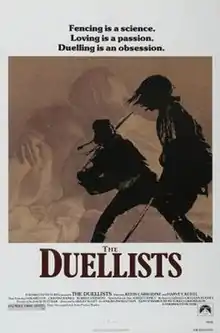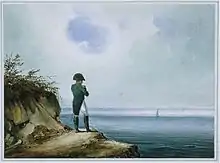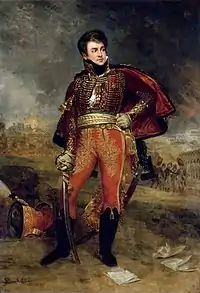The Duellists
The Duellists is a 1977 British historical drama film and the feature directorial debut of Ridley Scott. It won the Best Debut Film award at the 1977 Cannes Film Festival.[1] The basis of the screenplay is the Joseph Conrad short story "The Duel" (titled "Point of Honor" in the United States) published in A Set of Six.
| The Duellists | |
|---|---|
 Theatrical release poster | |
| Directed by | Ridley Scott |
| Produced by | David Puttnam |
| Screenplay by | Gerald Vaughan-Hughes |
| Based on | The Duel by Joseph Conrad |
| Starring | Keith Carradine Harvey Keitel Albert Finney Tom Conti |
| Music by | Howard Blake |
| Cinematography | Frank Tidy |
| Edited by | Pamela Power |
Production companies | Enigma Productions National Film Finance Consortium |
| Distributed by | Paramount Pictures |
Release date |
|
Running time | 100 minutes |
| Country | United Kingdom |
| Language | English |
| Budget | $900,000 |
Plot
Strasbourg 1800
- Opening Duel with Mayor's Nephew and the First Duel with Sabres
In Strasbourg in 1800, fervent Bonapartist and obsessive duellist Lieutenant Gabriel Feraud of the French 7th Hussars, nearly kills the nephew of the city's mayor in a sword duel. Under pressure from the mayor, Brigadier-General Treillard orders one of his staff officers, Lieutenant Armand d'Hubert of the 3rd Hussars, to put Feraud under house arrest. However, Feraud takes it as a personal insult when d'Hubert tells him he is under arrest at the house of Madame de Lionne, a prominent local lady. Matters are made worse when d'Hubert doesn't immediately reply when asked by Feraud if he would "let them spit on Napoleon". Upon reaching his quarters, Feraud challenges d'Hubert to a duel. The result is inconclusive; d'Hubert slashes Feraud's forearm but he is attacked by Feraud's mistress before he can finish him off. As a result of the fight, the General dismisses d'Hubert from his staff and returns him to active duty with his regiment.
Augsburg 1801
- The Second Duel with Small Swords, and Third Duel with Heavy Sabres
The war interrupts the men's quarrel and they do not meet again until six months later in Augsburg in 1801. Feraud immediately challenges d'Hubert to another duel with small swords and seriously wounds him. While recovering, d'Hubert takes lessons from a fencing master and in the next duel (held in a cellar with heavy sabres), the two men fight each other to a bloody standstill. Soon afterwards, d'Hubert is relieved to learn he has been promoted to captain. Military discipline forbids officers of different ranks from duelling.
Lubeck 1806
- The Fourth Duel with Sabres on Horseback
The action moves to 1806 when d'Hubert is serving in Lübeck. He is shocked to hear that the 7th Hussars have arrived in the city and that Feraud is now also a captain. Aware that in two weeks time he is to be promoted to major, d'Hubert attempts to slip away but is spotted by Feraud's perpetual second. Feraud challenges him to another duel which is to be fought on horseback with sabres, as a tribute to the cavalry. The duel is attended by many personnel from the military, especially cavalry, and a breakfast party is held by the spectators on the side while observing the duel.
D'Hubert slashes Feraud's forehead; covered by blood flowing into his eyes, Feraud can no longer fight. D'Hubert considers himself the victor and leaves the field ebullient. Soon afterwards, Feraud's regiment is posted to Spain, while d'Hubert remains stationed in Northern Europe.
Russia 1812
- Duel disrupted
Six years later the pair chance upon each other during the French Army's retreat from Moscow in 1812. But before their animosity can seize them, Russian Cossacks attack forcing d'Hubert and Feraud to fight together instead of against each other.
Tours 1815
Two years later, after Napoleon's exile to Elba, d'Hubert is a brigadier-general recovering from a leg wound at the home of his sister Leonie in Tours. She introduces him to Adele, the niece of her neighbour. The couple fall in love and are married. A Bonapartist agent attempts to recruit d'Hubert as rumours of Napoleon's imminent return from exile abound. But d'Hubert refuses to command a brigade if the Emperor returns from Elba. When Feraud, who is now a Bonapartist brigadier-general, learns this he declares he knew d'Hubert was a traitor to the Emperor, which is why he challenged him to a duel in the first place.
Paris 1816
- The Last Duel with Flintlock Pistols
_(18738290228)_(cropped).jpg.webp)
After Napoleon is defeated at Waterloo, d'Hubert joins the army of Louis XVIII. Feraud is arrested and is expected to be executed for his part in the Hundred Days. D'Hubert approaches the Minister of Police Joseph Fouché and persuades him to release Feraud (without revealing d'Hubert's part in his reprieve). Feraud is paroled to live in a certain province under police supervision.
After Feraud learns of d'Hubert's promotion in the new French Army, he sends two former officers to d'Hubert with a challenge for a flintlock pistol duel. Reluctantly d'Hubert agrees to the terms. The two men meet in a ruined château on a wooded hill. However, after Feraud rapidly discharges both his pistols, d'Hubert catches him at point blank range. But instead of shooting him, d'Hubert says that tradition dictates he now owns Feraud's life which means that in all future dealings with him, Feraud shall now conduct himself "as a dead man".

With that d'Hubert returns to his life and happy marriage. The film ends with a solitary Feraud gazing at the horizon in silent contemplation as he faces ending his days in provincial exile unable to pursue the obsession that has consumed him for so many years (the scene references paintings of the former Emperor in his South Atlantic exile[2] e.g. Napoleon on Saint Helena by Franz Josef Sandmann).
Cast
- Keith Carradine as Armand d'Hubert
- Harvey Keitel as Gabriel Feraud
- Albert Finney as Joseph Fouché, Minister of Police
- Edward Fox as Bonapartist agent
- Cristina Raines as Adele, later d'Hubert's wife
- Robert Stephens as Brigadier-General Treillard
- Tom Conti as Dr Jacquin, an army surgeon and friend of d'Hubert
- John McEnery as Feraud's tall second in the final duel
- Arthur Dignam as d'Hubert's one-eyed second in the final duel
- Diana Quick as Laura, d'Hubert's mistress
- Alun Armstrong as Lieutenant Lacourbe, a friend of d'Hubert
- Maurice Colbourne as Feraud's second
- Gay Hamilton as Feraud's mistress
- Meg Wynn Owen as Leonie, d'Hubert's sister
- Jenny Runacre as Madame de Lionne, a lady in Strasbourg
- Alan Webb as Adele's uncle
- Matthew Guinness as the Mayor of Strasbourg's nephew
- Dave Hill
- William Hobbs
- W. Morgan Sheppard as the fencing master
- Liz Smith as the fortune teller
- Hugh Fraser
- Michael Irving
- Tony Matthews
- Pete Postlethwaite as Treillard's valet (this was his first feature film appearance)
- Stacy Keach as the Narrator (voice only)
Production
Development
The Duellists would mark the feature film debut of Ridley Scott who had previously worked making TV commercials.[3] Its visual style was influenced by Stanley Kubrick's 1975 historical drama Barry Lyndon.[4] Due to budgetary constraints, Scott decided to shoot the film in a series of tableaux to indicate chapters of the story.[5]
Writing

Scott initially hired Gerald Vaughan-Hughes to write a story about Guy Fawkes and the 1605 Gunpowder Plot but when financing fell through,[6] Vaughan-Hughes adapted the screenplay from the 1907 novella The Duel by British-Polish writer Joseph Conrad.[7][8] The genesis of Conrad's story were the real duels during the Napoleonic era between two officers in France's Grande Armée, Pierre Dupont de l'Étang and François Fournier-Sarlovèze, who became D’Hubert and Feraud in The Duel.[9] In The Encyclopedia of the Sword, Nick Evangelista wrote:
As a young officer in Napoleon's Army, Dupont [l'Étang] was ordered to deliver a disagreeable message to a fellow officer, Fournier [Fournier-Sarlovèze], a rabid duellist. Fournier, taking out his subsequent rage on the messenger, challenged Dupont to a duel. This sparked a succession of encounters, waged with sword and pistol, that spanned decades. The contest was eventually resolved when Dupont was able to overcome Fournier in a pistol duel, forcing him to promise never to bother him again.[10]
The pair fought their first duel in 1794 from which Fournier-Sarlovèze - known as the “worst subject of the Grande Armée”[9] - demanded a rematch. At least another 30 rematches then occurred over the next 19 years in which the two officers fought mounted and on foot with swords, sabres, and pistols. After l'Étang finally bested Fournier-Sarlovèze in a duel, he told him to leave him alone for good. Fournier-Sarlovèze died aged 53; l'Étang lived till he was 74.[9]
Although Vaughan-Hughes screenplay used many elements from The Duel, it created new scenes like the duels at the start and the end of the film and new characters.[11]
Filming
Many exteriors were shot in and around Sarlat-la-Canéda in the Dordogne region of France. The winter scenes set during the retreat from Moscow were shot in the Cairngorms of Scotland, near Aviemore. The final duel scene was filmed at the unrestored Château de Commarque.[12]
Critical reception
_(18738290228).jpg.webp)
The film holds a 92% "Fresh" rating on Rotten Tomatoes based on 24 reviews, with an average score of 7.2/10 and the critical consensus: "Rich, stylized visuals work with effective performances in Ridley Scott's take on Joseph Conrad's Napoleonic story, resulting in an impressive feature film debut for the director."[13]
The film has been compared to Stanley Kubrick's Barry Lyndon. In both films, duels play an essential role. In his commentary for the DVD release of his film Scott comments that he was trying to emulate the lush cinematography of Kubrick's film, which approached the naturalistic paintings of the era depicted.
Vincent Canby of The New York Times wrote: "The movie, set during the Napoleonic Wars, uses its beauty much in the way that other movies use soundtrack music, to set mood, to complement scenes and even to contradict them. Sometimes it's all too much, yet the camerawork, which is by Frank Tidy, provides the Baroque style by which the movie operates on our senses, making the eccentric drama at first compelling and ultimately breathtaking."[14] Pauline Kael of The New Yorker wrote, "'The Duellists' is an epic yarn; we sit back and observe it, and it's consistently entertaining—and eerily beautiful."[15] Gene Siskel of the Chicago Tribune gave the film two-and-a-half stars out of four and wrote, "The story might have worked if there were an undercurrent of attractiveness to Keitel's loutish character. But he is an unwavering boor from start to finish, and his prowess with weapons is in no way redeeming."[16] Variety wrote that Ridley Scott "does have an eye for fine compositions, period recreation and arresting tableaus. But it is somewhat surface and too taken up with poses… it rarely illuminates the deeper human aspects of these two flailing men."[17] Charles Champlin of the Los Angeles Times wrote that the sword fights were "the best I've ever seen" and called the story "refreshingly different from standard film content."[18] Michael Webb of The Washington Post wrote, "The film has the pictorial beauty and rich period sense of 'Barry Lyndon,' but adds the narrative drive and passion that Kubrick's film lacked."[19] David Ansen of Newsweek wrote, "The best you can say about the film – the directing debut of Ridley Scott – is that it provides an unusually civilized experience in these days of movie barbarism… The worst that can be said is that Keitel and Carradine are so perversely cast as French hussars that, whenever they speak, the splendid illusion of nineteenth-century Europe is shattered."[20]
The film is lauded for its historically authentic portrayal of Napoleonic uniforms and military conduct, as well as its generally accurate early-19th-century fencing techniques as recreated by fight choreographer William Hobbs.[21][22] The military adviser was military historian Richard Holmes.
The New York Times placed the film on its Best 1000 Movies Ever list.[23]
Home media
On 29 January 2013, Shout! Factory released the film on Blu-ray.[24] The release coincided with the publication of an essay on the film in a collection of scholarly essays on Ridley Scott.[25]
References
- "Festival de Cannes: The Duellists". Festival-Cannes.com. Retrieved 10 May 2009.
- Barkman, Adam; Barkman, Ashley; Kang, Nancy, eds. (2013). The Culture and Philosophy of Ridley Scott. Rowman & Littlefield. p. 49. ISBN 9780739178720.
- "Ridley Scott: British director and producer". www.britannica.com. Retrieved 26 October 2020.
- "The Duellists: Ridley Scott". www.filmlinc.org. 26 October 2020.
- William B. Parrill (2011). Ridley Scott: A Critical Filmography. McFarland. p. 35. ISBN 9780786485932.
- Parrill, p.30
- "Gerald Vaughan-Hughes". www.bfi.org.uk. Retrieved 26 October 2020.
- Flavio Gregori (Summer 2010). "Youthful Resentment, Bourgeois (Anti-)Heroism and Sublime Unrest: Conrad's 'The Duel' and Ridley Scott's "The Duellists"". South Atlantic Review. 75 (3): 109–129. JSTOR 41635636.
- Anders Linnard (28 September 2018). "The real men behind The Duellists". www.historicalfencer.com.
- Evangelista, Nick (1995). The Encyclopedia of the Sword. Westport, CT: Greenwood Press. p. 187. ISBN 0-313-27896-2.
- Parrill, pp.32-34
- "Worldwide Guide to Movie Locations". www.movie-locations.com. Retrieved 26 October 2020.
- "The Duellists (1977)". Rotten Tomatoes. Flixter. Retrieved 23 December 2018.
- Canby, Vincent (January 14, 1978). "New Movie, 'The Duellists,' Is Set During Napoleonic Wars". The New York Times. 10.
- Kael, Pauline (January 23, 1978). "The Current Cinema". The New Yorker. 80.
- Siskel, Gene (April 2, 1979). "'The Duellists': Pretty, but plot is a lost cause". Chicago Tribune. Section 2, p. 7.
- "Film Reviews: The Duellists". Variety. June 1, 1977. 17.
- Champlin, Charles (January 27, 1978). "Taste of Steel in 'Duellists'". Los Angeles Times. Part IV, p. 1.
- Webb, Michael (June 3, 1977). "Cannes Festival: A Case of Expecting the Worst—and Getting It". The Washington Post. B4.
- Ansen, David (January 30, 1978). "Misfire". Newsweek. 55.
- Barkman, Adam; Barkman, Ashley; Kang, Nancy (2013), "10. Celebrating Historical Accuracy in The Duellists", The Culture and Philosophy of Ridley Scott, Lexington Books, pp. 171–78.
- "The Duellists: it takes two to tangle". The Guardian. 10 January 2016.
- The Best 1,000 Movies Ever Made. The New York Times via Internet Archive. Published April 29, 2003. Retrieved June 12, 2008.
- "The Duellists Blu-ray". Blu-ray.com. Retrieved 5 February 2014.
- "A Double-Edged Sword: Honor in The Duellists", in The Culture and Philosophy of Ridley Scott, eds. Adam Barkman, Ashley Barkman, and Jim McRae (Lexington Books, 2013), 45-60.
External links
| Wikimedia Commons has media related to The Duellists. |
- The Duellists at IMDb
- The Duellists at AllMovie
- "The Duel" – Full text of the short story by Joseph Conrad on which the film is based.